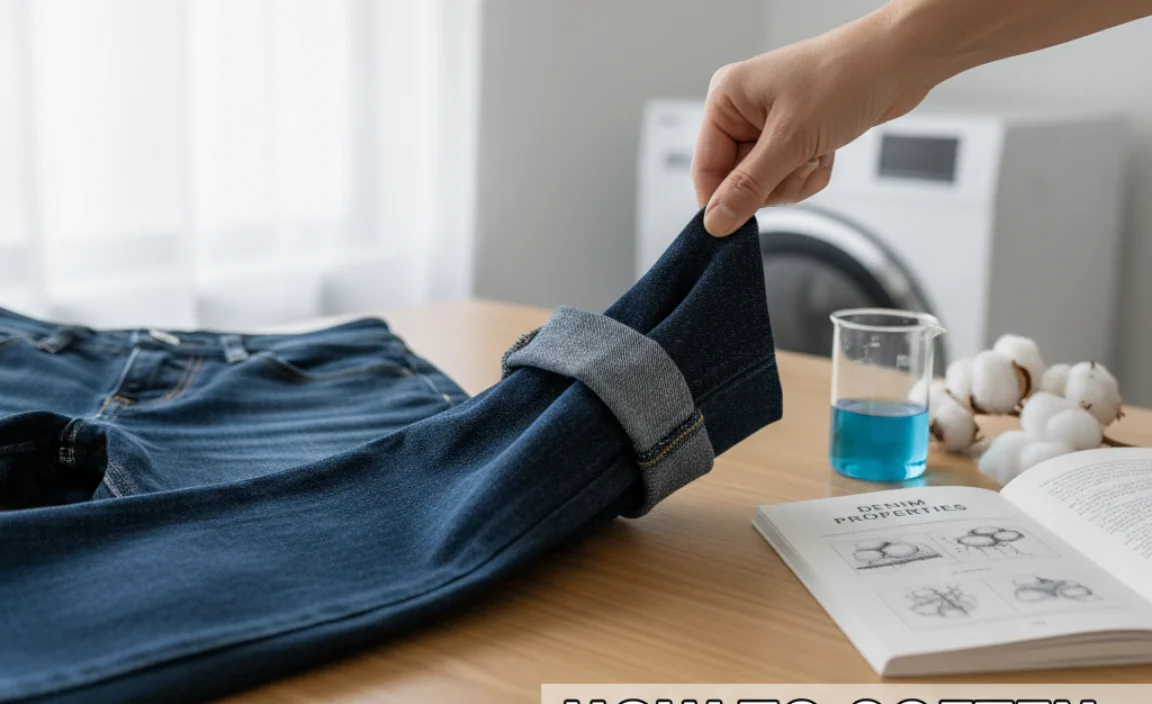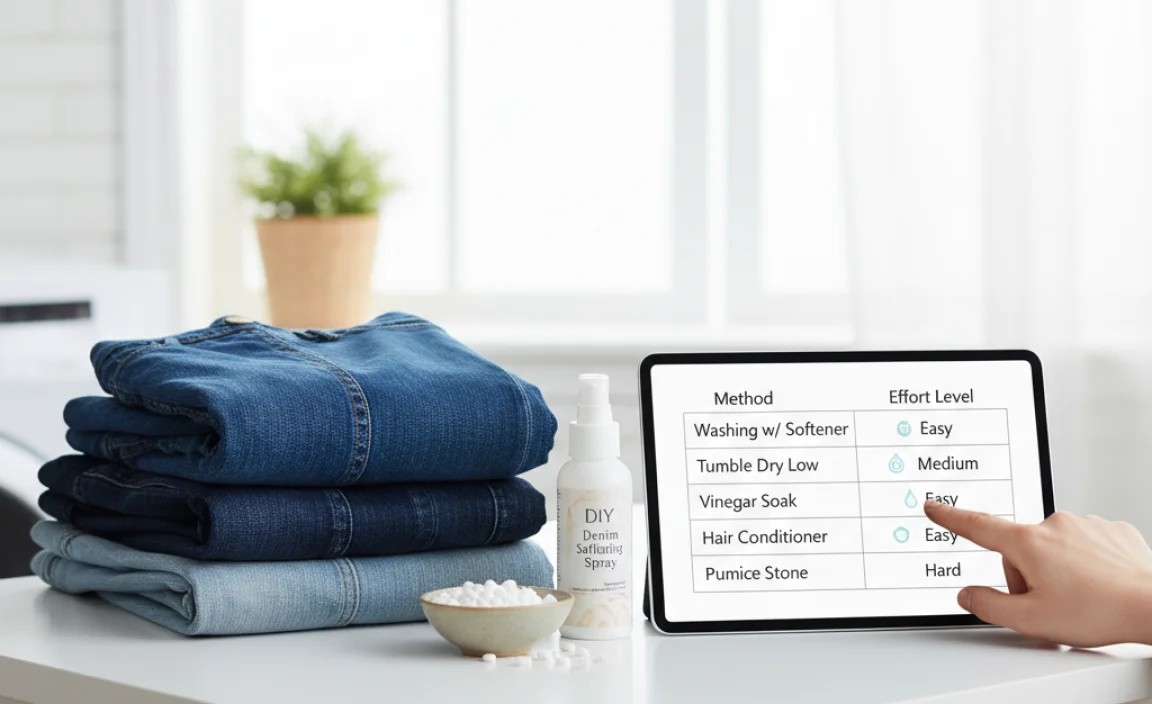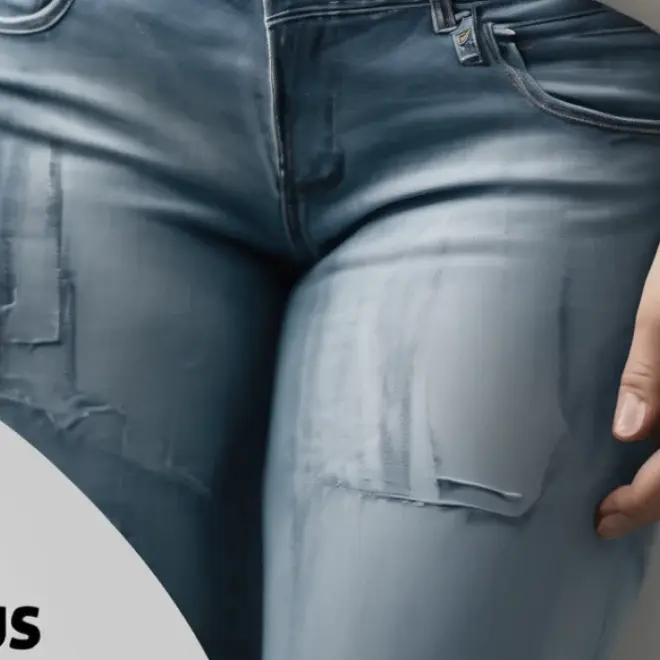Quick Summary
To soften new or stiff slim jeans, wash them in cold water with a gentle detergent and softener. Avoid harsh chemicals and high heat. Repeated wear and washing will naturally make them more comfortable over time.
How To Soften Slim Jeans: An Effortless Guide
Newly purchased slim jeans can sometimes feel stiff and a little unforgiving. This isn’t uncommon, as the fabric’s structure is designed to hold its shape. However, you don’t have to endure uncomfortable wear. With a few simple techniques, you can quickly make your slim jeans feel like old favorites. This guide will walk you through easy, effective methods to soften your denim, ensuring comfort and a perfect fit.
Why Do New Jeans Feel So Stiff?

Jeans, especially those with a slim fit, often use denim that is “raw” or has undergone minimal washing and distressing. This process helps preserve the fabric’s integrity and allows the jeans to mold to your body over time. However, for many, this initial stiffness can be quite uncomfortable. The goal is to achieve that broken-in feel without sacrificing the denim’s quality or fit.
Understanding Denim and Its Properties

Denim is a sturdy cotton twill textile. Traditionally, it’s made from a warp-faced weaving process, where the indigo-dyed warp threads are passed under two or more white weft threads. This gives denim its characteristic blue front and white underside. The tightness of the weave and the type of cotton used significantly impact how stiff or soft the fabric feels initially and how it softens over time.
Factors affecting stiffness include:
- Weave density: Tighter weaves are generally stiffer.
- Cotton type: Shorter staple cottons can feel rougher.
- Finishing processes: “Raw” or “dry” denim is unprocessed and stiff.
- Added components: Some jeans include elastane or other fibers that can affect initial feel, though they often soften up nicely.
The Best Methods to Soften Slim Jeans

Here are several proven methods to make your slim jeans more comfortable. You can use them individually or combine them for faster results.
1. The Washing Machine Method (Your Go-To)
Washing is the most straightforward way to soften denim. The key is to do it correctly to avoid damage.
Steps for Washing:
- Turn Jeans Inside Out: This protects the outer color and any embellishments from abrasion.
- Use Cold Water: Hot water can cause shrinkage and fade colors more aggressively. Cold water is gentler.
- Choose a Mild Detergent: Avoid harsh chemicals, bleach, or detergents with optical brighteners, which can strip color. A small amount of everyday laundry detergent is usually sufficient.
- Add Fabric Softener (Optional but Recommended): A small amount of liquid fabric softener or a dryer sheet added during the rinse cycle can make a significant difference. Ensure you use a softener safe for cotton.
- Select a Gentle Cycle: A delicate or permanent press cycle is best, as it uses less agitation.
- Skip the High Heat in the Dryer: After washing, tumble dry on a low heat setting or, ideally, air dry. High heat can make denim stiff again and can damage elastic fibers if present.
What to Avoid:
- Bleach: It will destroy the color and weaken the fabric.
- Excessive Detergent: Can leave residue that makes denim feel rough.
- Hot Water: Leads to shrinkage and aggressive fading.
- Aggressive Wash Cycles: Can cause premature wear and tear.
2. The “Wear Them In” Method (Patience is Key)
The most natural way to soften jeans is simply by wearing them. Each movement helps to break down the fabric fibers, making them more pliable and conforming to your shape.
- Embrace Daily Wear: Wear your slim jeans as often as possible. The more you move in them, the faster they will soften.
- Don’t Wash Too Frequently: While washing softens jeans, over-washing can accelerate fading and wear. Try to wash only when necessary, especially with raw denim.
- Bend and Stretch Regularly: When you’re wearing them, consciously perform movements like squats, lunges, or simply stretching your legs. This helps the denim fibers adapt to your body’s natural lines.
This method is best for those who are patient or have jeans that are only slightly stiff. For significantly stiff denim, combining this with other methods is more efficient. The Natural Fiber Education community provides excellent resources on the longevity of cotton garments, emphasizing the benefits of natural wear-and-tear for comfort: Cotton Care Guide.
3. The “Soaking” Method (Deep Softening)
Soaking can be a great precursor to washing or an alternative if you want to avoid machine agitation.
Steps for Soaking:
- Fill a Tub or Large Basin: Use cool or lukewarm water.
- Add a Softening Agent: You can add a small amount of mild detergent, fabric softener, or even a natural option like a cup of white vinegar (which also helps remove detergent residue and odors).
- Submerge the Jeans: Ensure the denim is fully saturated.
- Soak for Several Hours: A minimum of 2-4 hours is good, but you can leave them overnight for tougher denim.
- Gently Agitate: Swish the jeans around in the water periodically to help the softening agent penetrate the fibers.
- Rinse Thoroughly: Drain the soapy water and rinse the jeans with clean, cool water until all residue is gone.
- Wring Out Gently: Press out excess water, but don’t wring too harshly, as this can damage fibers.
- Air Dry: Lay flat or hang to dry.
Pro Tip: Soaking with vinegar is particularly effective for removing any stiffness from sizing chemicals used in manufacturing.
4. The “Heavy Duty” Wash (For Extremely Stiff Denim)
If your jeans are exceptionally rigid, you might consider a slightly more robust wash, but always proceed with caution.
Steps:
- Wash Alone or with other dark, sturdy items to prevent color transfer.
- Use Warm Water (Not Hot): This can help break down stiff fibers more effectively than cold water.
- Add Half a Cup of Baking Soda to the wash drum. Baking soda acts as a natural fabric softener and brightener.
- Use Your Regular Detergent and an additional rinse cycle.
- Tumble Dry on Medium Heat for a short period, then finish by air drying. Follow up with wearing them to complete the breaking-in process.
Remember, this method carries a slightly higher risk of fading, so it’s best reserved for very stiff, dark-wash jeans.
Table: Softening Methods at a Glance

Here’s a quick comparison of the common methods:
| Method | Best For | Pros | Cons | Effort Level |
|---|---|---|---|---|
| Washing Machine | General softening, regular maintenance | Efficient, reaches all areas | Risk of over-fading or shrinkage if done incorrectly | Low |
| Wearing Them In | Slight stiffness, natural break-in | No risk of damage, molds to body | Slow process, requires patience | Very Low (just wear them) |
| Soaking | Deep softening, removing residue | Gentle on fabric, effective for stiffness | Time-consuming, requires space | Medium |
| Heavy Duty Wash | Extremely stiff, rigid denim | Can break down very tough fibers | Higher risk of fading/wear | Medium |
Advanced Tips for Denim Care and Softening

Beyond the basic wash, consider these expert tips:
- Check the Care Label: Always consult the manufacturer’s tag for specific washing and drying instructions. This is the most reliable source of information for your specific jeans.
- Invest in Quality Denim: Higher quality cotton denim will generally soften better and last longer than cheaper alternatives.
- Embrace the Stretch: If your slim jeans have a small percentage of elastane or spandex, they will naturally soften and stretch to fit you more comfortably over time. Be mindful not to over-stretch them in the dryer.
- Consider Laundering with Other Soft Items: If air drying is difficult, tumbling with soft towels can help maintain some softness, but avoid using fabric softener sheets directly on jeans if you’re concerned about residue.
- Avoid Dry Cleaning: Dry cleaning chemicals can damage denim fibers and alter their texture permanently.
The Federal Trade Commission offers general advice on clothing care that aligns with these principles of gentle treatment.
How to Test if Your Jeans Have Softened
You’ll know your jeans have softened when:
- They feel more pliable in your hands.
- They don’t feel constricting when you sit or move.
- The fabric drapes more naturally rather than standing stiffly.
- They feel comfortable against your skin without any scratchiness.
FAQ: Your Slim Jean Softening Questions Answered
Q1: How quickly can I expect my slim jeans to soften?
A: With regular wear and a few washes, you can feel a noticeable difference in softness within a week or two. For very stiff denim, using soaking or a warmer wash might speed this up, but natural wear is the ultimate softening agent.
Q2: Will washing my slim jeans make them shrink?
A: Yes, denim especially 100% cotton denim can shrink, particularly with hot water and high heat drying. Using cold water, a gentle cycle, and air drying or low heat will minimize shrinkage.
Q3: Can I use bleach to soften my jeans?
A: No, bleach should be avoided. It will damage the denim fibers, remove color unevenly, and make the fabric brittle, not soft.
Q4: My slim jeans feel stiff even after washing. What else can I do?
A: Try soaking them in cool water with fabric softener or a cup of white vinegar for a few hours, followed by a gentle wash and air dry. Consistent wear is also crucial for breaking in stiff denim.
Q5: Is it okay to put fabric softener sheets in the dryer?
A: While fabric softener sheets can add softness, they can also leave a waxy residue on denim, potentially affecting its breathability and look over time. Using liquid softener in the wash cycle or air drying is generally a safer bet for preserving denim quality.
Q6: How should I dry my slim jeans to keep them soft?
A: Air drying is the best method for softness and longevity. If you must use a dryer, choose the lowest heat setting and remove them while still slightly damp to finish air drying. High heat makes denim stiff and can damage elasticity.
Q7: Can I soften jeans made with stretch fabric better than 100% cotton?
A: Jeans with a blend of cotton and elastane (like 1-3%) often soften more quickly and comfortably because the synthetic fibers are more pliable. However, always follow care instructions, as excessive heat can degrade these fibers.
Conclusion
Softening new slim jeans transforms them from a potentially stiff garment into a comfortable, go-to piece in your wardrobe. By employing gentle washing techniques, embracing natural wear, or utilizing soaking methods, you can achieve that desired broken-in feel without compromising the integrity of your denim. Remember to always check care labels and prioritize cool water and low heat to protect your jeans. With a little patience and these straightforward methods, your slim jeans will be fitting and feeling like a dream in no time.











